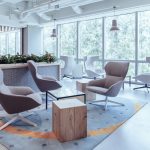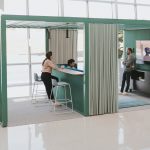The 4 Design Elements That You Need for a Legible Workspace
Rapidly changing technology and the influx of millennials and Gen Z in the workplace continue to change the way offices are designed. The work style of the new workforce is much more collaborative and driven by the need for social connections. Further, they want choices in the way that they work, so they need a variety of options from which to choose. They don’t want rows of cubicles or private offices, they want excitement and diversity in the look and feel of their space. So the workplace continues to change in order to suit their needs.
Office design is now focusing on creating legibility in the workspace.
What is a legible workspace?
Legibility is a people-centered approach that offers office configurations that are easy to navigate and easy to understand. According to Ann Harten of Haworth, “Legibility can be designed into the office space by using landmarks that help people orient themselves. One can also leverage outside landmarks and signage to further guide people. These markers allow employees to create a “mental map” of the layout and find any location within the building, even with limited experience with that building.” For millennials, and especially for Gen Z, the intended use of a space needs to be clear, if there is any sort of ambiguity about what a space is supposed to be used for, the space will simply be wasted because they will avoid using it.
If your space is designed with legibility in mind, your employees benefit because it will make choosing a spot for their next task and the transition between different work modes easier and quicker for everyone. It reduces the amount of energy, time and stress related to navigating the space which makes the workplace more effective and productive.
The legibility of your space can be accomplished through these simple design elements:
- Landmarks: Interior features such as a kitchen area or breakout space act as landmarks which are important physical cues within a building. They can also be outside the facility, such as other buildings or landscapes that can be seen through windows. Landmarks are important because they serve as a way people can anchor themselves in the space.
- Plan configuration: The configuration of a workspace needs to be as clear as possible and easy to understand. When configuration of a space is irregular, or cubicle farms, it creates confusion and stress for employees.
- Visual access: It is important that the workspace is open without workstations or walls blocking visual access. This will allow people entering the space to see landmarks, make a quick mental map in order to navigate their workspace easily.
- Signage: Signage can also serve as landmarks or provide information about the intended use of the space.
If you want to increase the legibility of your space, Bellia can help. We will do a thorough evaluation of your space to help you determine ways that you can have a legible workspace that will increase the efficiency, productivity and happiness of your employees, Give us a call today!










